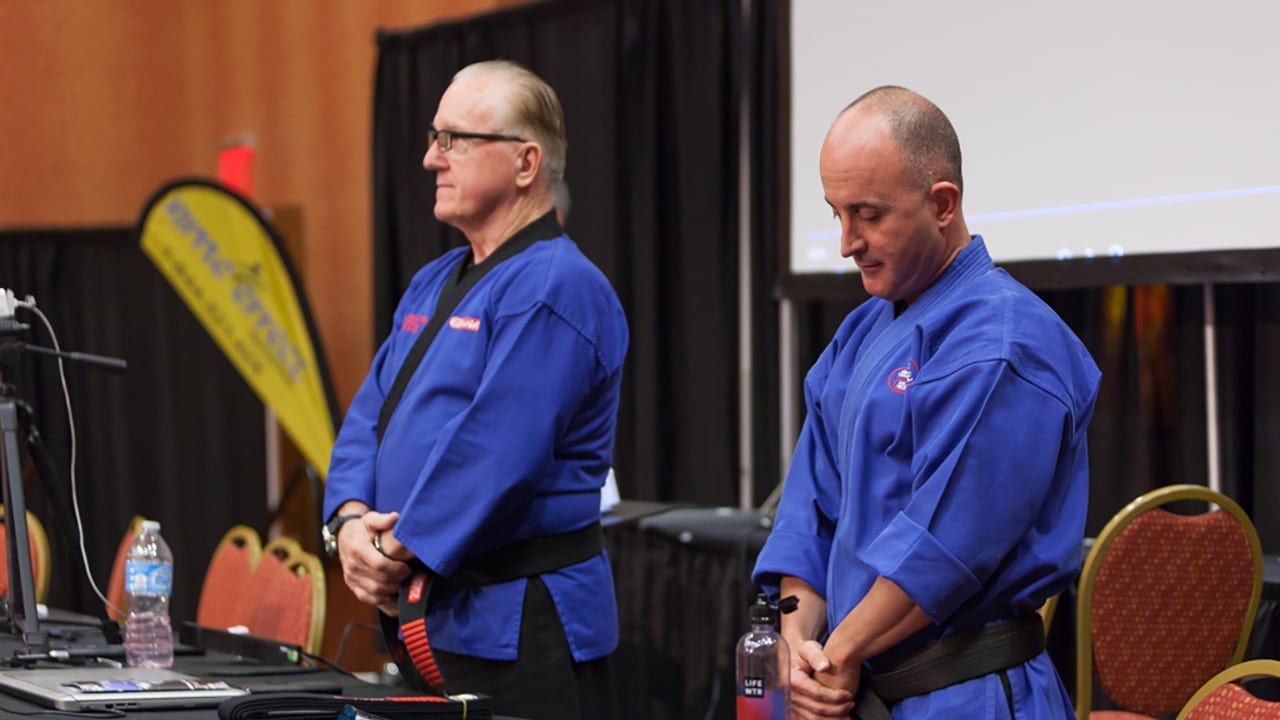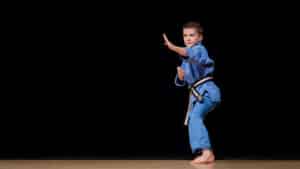Master/student relationships are legendary in the martial arts.
We were honored to welcome 10th-degree Black Belt Grand Master Jeff Smith and one of his students, Grand Master Mark Glazier, to Ripple Effect Martial Arts’ inaugural Black Belt Immersion in April. Grandmaster Glazier was awarded his 8th-degree Black Belt after nearly four decades of training under Smith in the methods originally taught by Jhoon Rhee, the “Father of American Taekwondo.”
Both Grand Masters were kind enough to sit with me for an interview in which they describe their humble beginnings and remarkable accomplishments in the martial arts, from business innovations to honoring their lineage through Grand Master Rhee.
Where did you first encounter the martial arts? What did your family think of you training to fight?
SMITH: My mother worked at Texas A&I University, where I delivered newspapers when I was in junior high school. One day on my route I noticed a sign for a karate demonstration at the student union ballroom. I went and watched and wanted to enroll, but it was for college students only. I talked to my mother, she talked to the dean, and he decided to let me in.
My parents didn’t know really anything about the martial arts. Back then, not very many people [in America] did, and I actually did it without my parents knowing what exactly I was getting into.
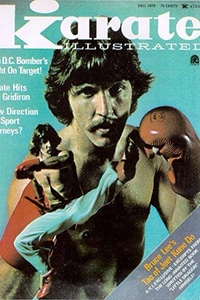
Were you warmly received?
SMITH: Yes and no [laughs]. Those college kids didn’t want high school or junior high kids there, so they didn’t make it too easy on me. And at that time, when you were a white belt, you sparred. You didn’t wait to get your bearings after a couple belts.
There were no pads, either. No mouthguard, cup or nothing. You just started sparring from day one.
It was more a club than an actual school, and we practiced in the gym or the studio ballroom; they bumped us from one [space] to another. When both those were booked, they just moved us somewhere else. Jhoon Rhee would come every semester to oversee and teach and rank us. And that’s how I got started, back in 1964.
Grandmaster Glazier, what do you remember about your beginnings in the martial arts?
GLAZIER: I started when I was very young, 7 or 8 years old. My story is similar [to Grand Master Smith’s], starting in makeshift clubs rather than schools, but I jumped around for many years in my early training.
I’d wait to get out of elementary school every day and rush out, back in 2nd or 3rd grade, to train. From my first day I was just totally into it. My parents weren’t too into it [laughs].
What stands out about those early days?
GLAZIER: I’d train in stuff [I’d seen but] wasn’t even being taught. My first pair of nunchucks, when I was like ten years old, I made with broom handles, with a hollow shower curtain rod, a steel rod, over the wood [laughs]. I trained for hours and hours a day. Martial arts was part of my [identity], my everyday being.
How did you go from beginner to more advanced training in the martial arts?
GLAZIER: The renaissance of my career was moving to D.C. in 1980 [to attend American University]. Someone introduced me to Grand Master Smith and, for some reason, he took a liking to me [laughs]. He brought me into the organization and I started training in taekwondo out of his school in Falls Church, Virginia. I had to learn a whole new [approach to] martial arts.
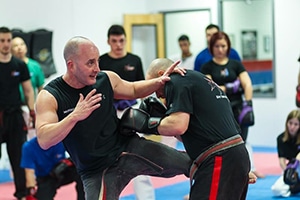
What was different?
GLAZIER: Grand Master Smith introduced me to continuous sparring, which was very different from the way I had trained.
Where I came from in Jersey, we thought we were tough. But we didn’t actually hit, so we didn’t know what the pads were for. I’d never hit anybody like that. The way I’d trained we never made any contact. So I walked into the gym [with Grand Master Smith’s students] with no idea why anybody would wear pads. I found out pretty quick.
Was the “blood and guts” era still alive then, in a sense?
SMITH: Well, a lot of guys came and said they wanted to learn the martial arts. But we didn’t take it easy on them. We’d beat the hell out of ‘em. Half—or more—never showed up for a second session. That was it, they got their tail whipped, they didn’t want to come back. The ones who came back, I knew they were more serious. Mark was one of those.
So it was a toughening up? Gotta walk the walk?
SMITH: You had to show that you were serious about the training, that you had heart. Now and for most of his professional career, Mark’s been very muscular. Back then, he was about 135 pounds soaking wet.
GLAZIER: I used to wear a size 3 uniform.
SMITH: My daughter wears a size 3 uniform [laughs]. It’s not a big uniform.
What were some of the things you taught Grandmaster Glazier when he began training with you?
SMITH: I could tell that Mark had learned only one dimension of training, which was point fighting. You throw one technique then stop. He didn’t know how to combine techniques, so maybe he’d land a strike on somebody, but they’d land four or five techniques on him. He learned quickly that you had to work in combinations. You can’t stop after that first shot.
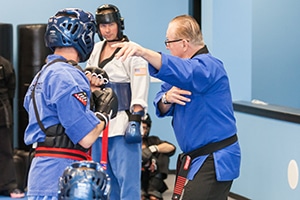
GLAZIER: I had a lot of flashy kicks. But they never made contact. I couldn’t even hit their headgear; my foot would automatically stop. I had to totally retrain myself under Grand Master Smith and his students to actually make contact with my kicks, which I had always been taught to pull.
What made you give Grand Master Glazier his start in the business of running a martial arts school?
SMITH: Mark was very sharp on the business side of things, so we eventually hired him as a manager of the Jhoon Rhee Institute and moved him from schools in Annandale, Alexandria, Hyattsville, and eventually to the Jhoon Rhee Institute in Kensington, Maryland. He got to train that way with lots of our top instructors and Black Belts and also get involved in the business, which was a very good fit for our organization.
What have 37 years of training under an international champion taught you?
GLAZIER: Respect. When you’re young, you need someone to look up to. And I’ve never stopped looking up [to Grand Master Smith]. Over nearly 40 years, I’ve learned from Grand Master Smith that martial arts [informs all] you do in life. And that you have to keep pushing forward with it.
He would keep pushing me further and further. You don’t earn a Black Belt and stop, win some trophies and stop, wear a belt because you earned it ten years ago. You need to earn that belt through continual training. [You have to] incorporate martial arts, the disciplines, the intensity, the drive, into your life every day. Grand Master Smith hasn’t stopped from the day I met him. It was like that in 1980. It’s been that way ever since.
[Watch Grand Master Glazier pay an impromptu tribute to Jeff Smith in front of 50 Black Belt testers—ed.]
What went into your decision to award Grand Master Glazier the advanced rank of 8th degree Black Belt?
SMITH: Mark has developed a superior martial arts organization, [Master Glazier Karate], in New Jersey and he’s at the top of it. He needed to move up in the levels. But I’ve never been one to just give somebody a belt. If you want to move up to the highest levels, I need to make sure you’re committed.
Some years ago, training for his 6th degree, Mark would make the five-hour round trip to D.C. from New Jersey every Sunday to train for six hours, with a slight break for lunch, with me and my Black Belt students–many of whom were the top tournament champions in the nation. He did this for a full year, on top of the training, teaching and business he had going on back home.
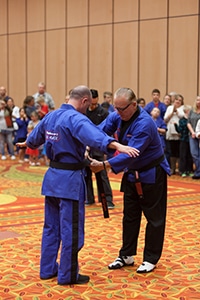
I’ve had lots of guys ask me to promote them. But I’ve only promoted one other 8th degree in 57 years, and that’s [Mile High Karate founder] Stephen Oliver. One 9th degree, and that’s Stephen Oliver. You can count on one hand the people I’ve promoted to even 5th degree, and that includes [Ripple Effect Martial Arts founder and Master Instructor] Greg Macy. [Watch Master Macy spar as part of his 5th-degree Black Belt test—ed.]
What about Grand Master Glazier’s legacy in the martial arts stands out to you, as his teacher?
SMITH: Mark has taken the ball and run with it. He’s been on martial arts magazine covers, won tournaments, championships. But he’s also done some things that no one, at least to my knowledge, has done in the industry. This includes bringing his franchise public on the New York Stock Exchange. He’s also developed what many consider the best supplements on the market for athletes, NutriBio.
When I first walked in and saw his school, his students, his instructors, I was incredibly impressed. Everyone talked about the quality of his school and system, how clean, how sharp, how organized it is, setting a new standard for the industry. All while keeping with the techniques and tradition of Grand Master Jhoon Rhee.
What’s your advice to martial artists looking to take their training further or become instructors—or even future Grand Masters—themselves?
GLAZIER: A martial arts school is a business, and you’ve gotta be smart [in the way you run it]. But at the heart of that business is the quality of training and care for the students. A little while back [kickboxing legend] Bill Wallace and Grand Master Smith came to our school and it was such an honor to get compliments from them on my students, one of them now a 5th-degree Black Belt and teaching students himself. How much heart they had, how well they trained. That was what Grand Master Smith saw in me all those years ago. It still makes me proud.
SMITH: You can see that quality in students that have been trained in the methods of Grandmaster Rhee, that they belong to that lineage. To anyone able to recognize the quality of those techniques, that level of martial arts training, it makes all the difference.
